Dear Barbara,
It’s a wonderful road trip around Armenia. Petros drives the car under the autumn sun. He is a violinist, and he talks with passion about music as well as about Armenia. All around us, the tall Armenian mountains are already covered with snow. You can see the picks almost touching the sky. But, as you already know from my letter from Yerevan, there is a mountain that nothing compares to it: Mount Ararat.
We started rather early with our tour around Armenia. I still feel a bit sleepy, but there’s a fresh wind coming through the open window. But the landscape somehow awakens me. We listen to the songs of Charles Aznavour that passed just a couple of days ago. Every car, every cafe, and every balcony plays his music these days in Armenia. That’s what one might call a proper tribute to a national hero.
I can see tall trees all around me, and Ararat is always there. It’s the beginning of winter, and I’m here in Armenia for the first time. It’s going to be a long, beautiful day.
Charents’ Arch in Armenia

We stop at Charent’s Arch. At first, I can’t truly understand what is so special about the place. A man is playing accordion nearby, while stray dogs walk up and down, searching for new friends. A few meters inside the path, I see an arch. “Wait, and you’ll see,” Petros says. As we walk towards the arch, it becomes apparent why we stopped here: Mount Ararat.
This is one of the most prime viewpoints all around Armenia, and the views of Ararat are spectacular. This arch was built back in 1957 as a tribute to Armenia’s most prominent poet, Yeghishe Charents. Recognized as Armenia’s top poet for the 20th century, Charents was supposedly visiting frequently this very spot. It was the place that he’d find inspiration, and also, he could have clear views of his beloved Mount Ararat.
I remain ecstatic for some minutes, and then I walk a little bit further down. On the front side, there are some words by Charents, a verse coming from his most famous poem. It reads: “Pass the whole world with its mountains white, to the beauty of Masis equals none!”
A Greek temple in Armenia
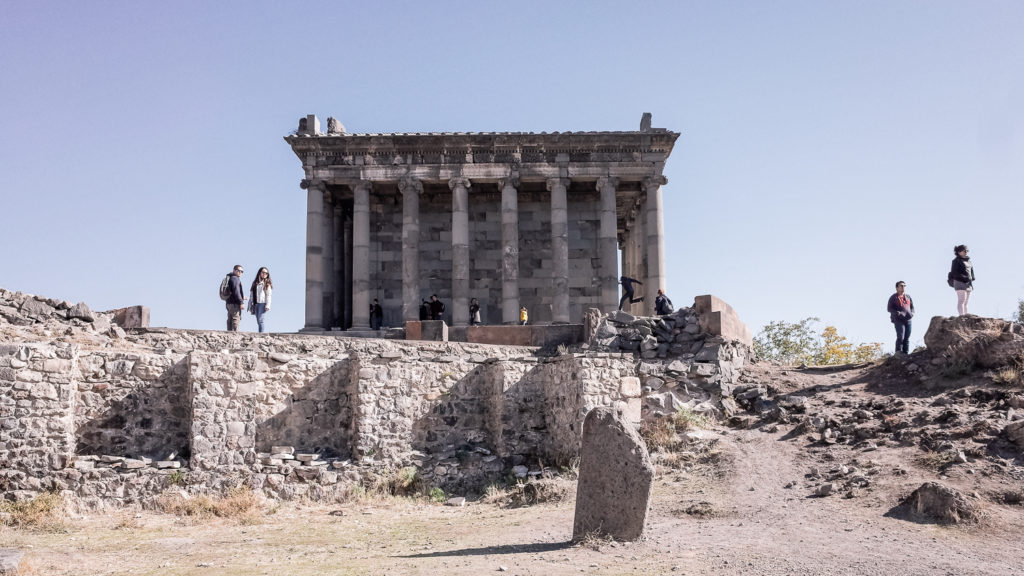
Shortly after Charent’s Arch, we have to stop again. But this time the place has loads of people. Street vendors selling honey and local products while a bunch of tourists shoots selfies among them.
“We are here for the Garni Temple,” says Petros, “which is the only standing Greco-Roman temple in Armenia.” The temple has a long history of destruction, and it collapsed completely in the 1679 earthquake. Its anastylosis took place in the mid-’70s and today is regarded as an iconic building. This is definitely an impressive temple, and its location is equally impressive: cliffs surround it, and at all times, you can hear a flowing river.
The temple of Garni has unusually high steps, approximately 30 cm, and according to a theory, this is probably because one has to feel humbled while trying to reach the altar. That said, apart from the spiritual effort, there should also be a physical one. The interior is not very big, though, and historians assume that there was also a statue standing there in former times.
Geghard, a monastery carved in a rock
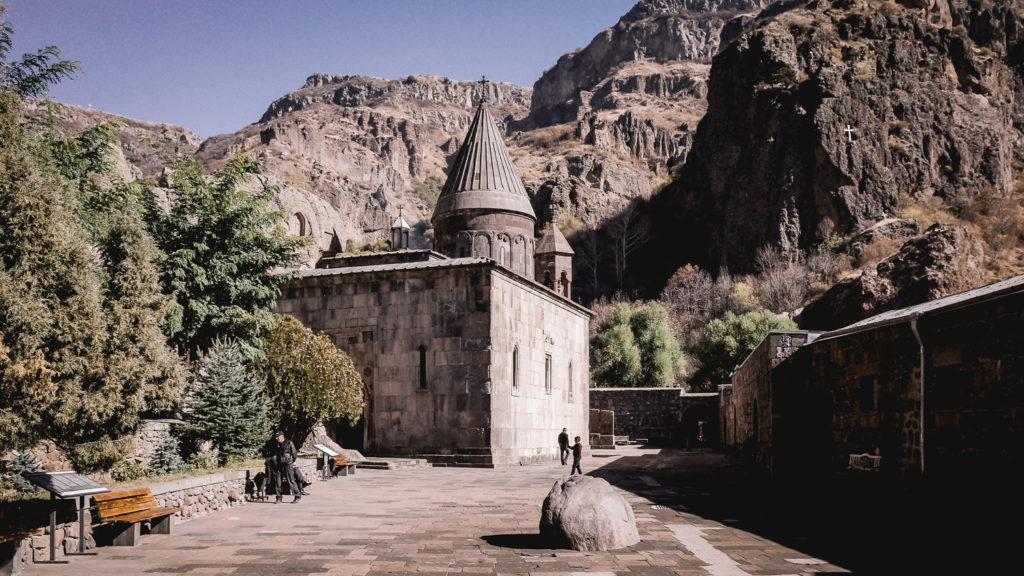
We leave the temple of Garni behind, and the road leads to the Geghard Monastery. “This is one fine example of medieval architecture says,” Petros says. This big monastery is carved in rock and is surrounded by breathtaking scenery: built among cliffs, on the Azat Valley entrance.
The monastery of Geghard contains a number of churches and tombs. According to the folk tradition, the monastery founder is St. Gregory the Illuminator, and it was built following the adoption of Christianity as a state religion in Armenia. “Everything is built between the 4th and the 13th century AD”, is what Petros tells me. We soon enter the upper floor, where we are luckily alone. Then, Petros starts to sing some religious melody. What he wants to prove by singing is the acoustic of the building. Indeed this is a place created out of stone, and its acoustic is close to perfection.
What I find even more interesting is the story of the khachkars. A khachkar is a carved memorial board made of stone, and its decoration consists always of a cross, accompanied by additional carved ornaments, like religious and botanical motifs. “Every khachkar is unique,” says Petros. “Even if some of them look the same, there are fine details that make them different. They usually have three different sections”, he continues, “the upper one, where you see decorations, the middle one, where you see the cross, and the lower one that has some extra motifs.”
At the entrance of the Geghard Monastery, six khachkars are standing. “Look at them,” Petros insists. I do pay close attention to them, and indeed they are different. “Wherever there is an Armenian community around the world,” he says, “there will always be a khachkar nearby.”
The bread of those early years
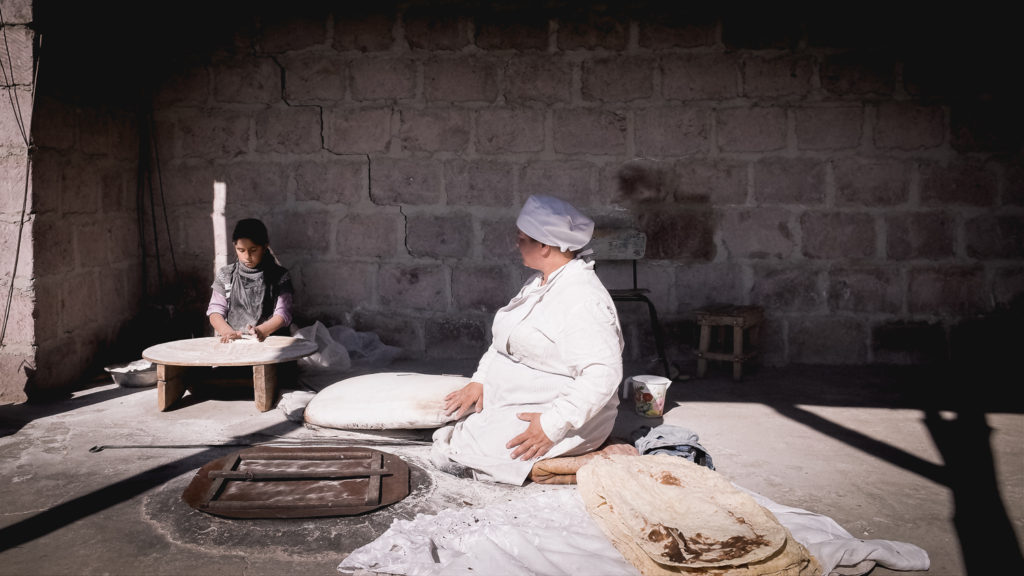
It’s only a few hundred meters after we leave the monastery when I ask Petros: “What are they doing?”
People are standing in an unfinished building consisting of cement, and there is white smoke around them. But the smell is fine; they are not burning something, they are making food. “They actually make lavash,” Petros corrects me. Lavash is the traditional bread of Armenia. It is easy to make as you need only three ingredients: flour, water, and salt. The preparation is also easy: it has to be heated at a very high temperature for a few seconds. “Can we stop?” I ask. A moment later, we exit the car, and we walk towards the people.
They are extremely friendly, and before I even understand what’s going on, I find myself drinking homemade vodka in the early afternoon. The drink is very strong, it has 60 degrees of alcohol, and soon I’m tipsy. Then, I start to observe the scene. A woman is sitting on the floor while her daughter sits next to her. The young girl -she is 9 years old- is making the pastry sheet, and when it’s ready, she passes it to her mom.
Then, the woman opens the cap of an oven attached to the concrete, and she places the pastry sheet on the inner walls of the cylindrical oven. The sheet remains there for a few seconds (twenty or thirty, I’d say, but the vodka won’t let me calculate properly), and then the woman removes it and places it on a pile of lavash.
The family sells lavash to the nearby cities. This is the place that you can eat bread as fresh as possible, though. Her husband is cutting fresh tomatoes and brings some local white cheese. All you have to do is cut slices of cheese and tomato, place them on the lavash and then roll it like a wrap. This is a delicious lunch. The family dogs are playful; they are confronting a bull that walks by in front of us. The dogs manage somehow to scare the bull. It’s true, it’s not the vodka.
At the lake Sevan of Armenia
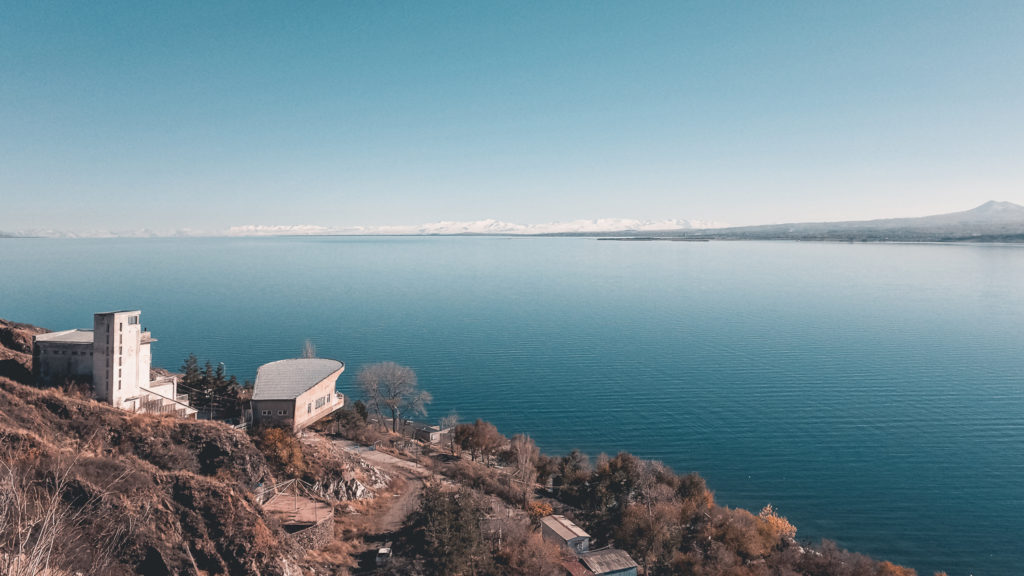
Petros didn’t drink vodka at all, but I had four snaps, and I’m semi-drunk. I’m half asleep on the way to Lake Sevan, and I open now and then the window to get some fresh air. I feel like I’m observing everything in a more blurry, cinematic way, and I lay comfortably on my seat and enjoy the flowing landscape.
We both start to yawn: we are ascending to a much higher altitude rapidly, the Lake Sevan lies at an elevation of 2,000 meters. “The body needs more oxygen now, and this is the way to adjust its levels,” Petros says. Of course, this is the easy part, yawning and relaxing in a car, because the more tough part comes when I arrive at Lake Sevan.
The landscape is truly magnificent, and we even see some snow on the way. But, to reach the top of the lake, you need to climb 238 steps -“I have counted them many times, don’t bother counting them, too.” At sea level, this would have been an easy task, but the truth is I’ve never done anything like that drunk in 2,000 meters.
We are ascending at a normal pace, and we are truly rewarded when we reach the top. The lake appears to be as wide as the sea. There are two churches on the top, and if you walk a bit further up, there are also the relics of the ancient church: the Soviets destroyed it. All the surrounding mountains are already covered by snow, but today is a sunny day. It’s only 13 degrees, but due to the sun, it feels like 22-25 degrees.
We get inside the church, and Petros shows me a very old khachkar. It has fine details, but unfortunately, my memory fails me. I feel dizzy, and I fail to recall most of the info. On the way down, I remember talking Greek with some guy born in Russia.
One last stop
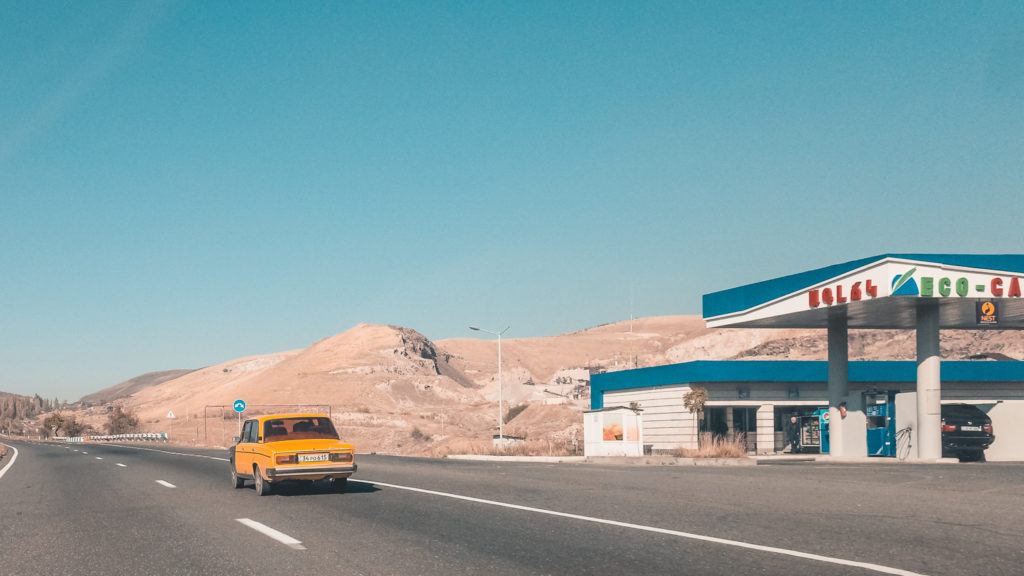
I slept in the car, and I’m now awake. I’m writing to you actually from the car, Barbara. There is one last stop on the journey, but I will have to write tomorrow about it. As you probably remember from my Anafi letter, I’m about to meet someone. It’s a mysterious stranger with a bizarre story. And guess what: time has come.
I’m feeling better, and I’m not dizzy anymore. We are almost there now. I will write to you soon.
Take care,
George
*You can book a similar tour here.
More about Armenia: Things to do in Armenia & Checkmate in Yerevan
*Get my FREE Travel Writing Course*
Buy the camera I use | Book your hotel
Pin It for later
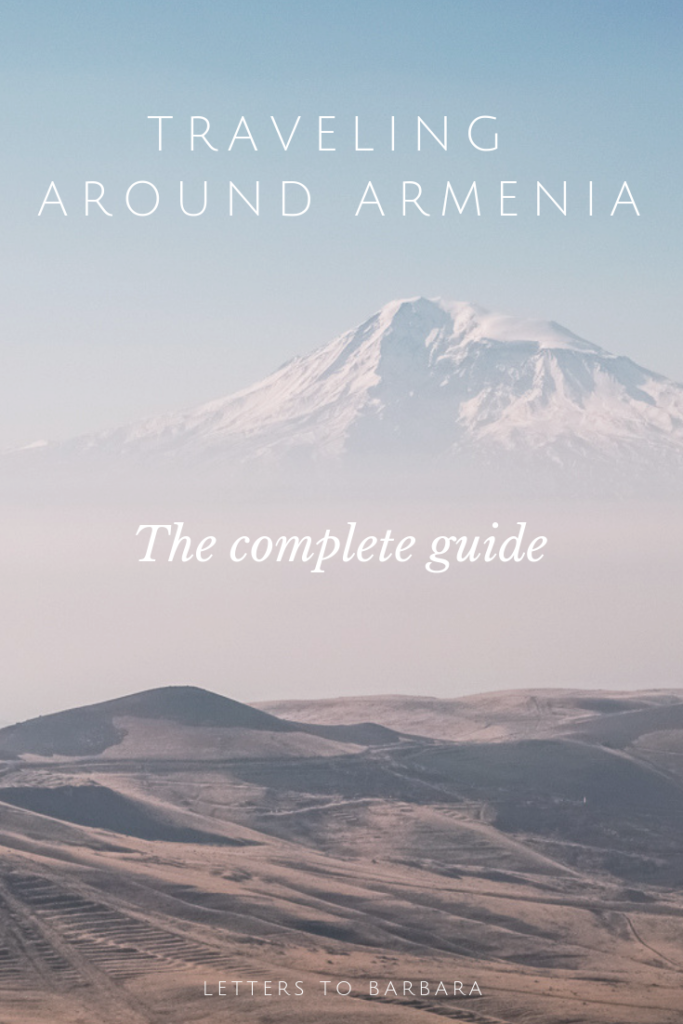
Please share, tweet, and pin if you enjoyed reading The Stories of Armenia. Your support keeps this website running and all the info up-to-date. 🙂
Last Updated on October 25, 2020 by George Pavlopoulos
